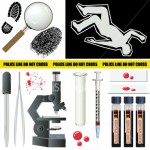 Last weekend I had the pleasure to participate in a conference sponsored by the Wisconsin Association of Criminal Defense Lawyers entitled, “Whatever Happened to the Science in Forensic Science?” The conference centered upon the 2009 report by the National Academy of Science (NAS) that confirmed suspected and significant concerns about how the criminal justice system had been using science for decades. And as if the NAS report wasn’t bleak enough, a number of speakers pointed to looming problems with DNA evidence, heretofore the vaunted “gold standard” for forensic science, and even with medical experts who diagnose child abuse. In sum, the whole field is starting to resemble a mass of toxic Hungarian red sludge that is oozing over and through the law’s inadequate bulwarks. (And no, I don’t believe that the answer is the Daubert “reliability” standard, which has proven to be ineffectual in most ways and pernicious in others.)
Last weekend I had the pleasure to participate in a conference sponsored by the Wisconsin Association of Criminal Defense Lawyers entitled, “Whatever Happened to the Science in Forensic Science?” The conference centered upon the 2009 report by the National Academy of Science (NAS) that confirmed suspected and significant concerns about how the criminal justice system had been using science for decades. And as if the NAS report wasn’t bleak enough, a number of speakers pointed to looming problems with DNA evidence, heretofore the vaunted “gold standard” for forensic science, and even with medical experts who diagnose child abuse. In sum, the whole field is starting to resemble a mass of toxic Hungarian red sludge that is oozing over and through the law’s inadequate bulwarks. (And no, I don’t believe that the answer is the Daubert “reliability” standard, which has proven to be ineffectual in most ways and pernicious in others.)
Kudos for organizing the conference go to Amelia Bizzaro (Law ‘03). The conference drew excellent criminal lawyers and forensic experts from across the country (Boston, New York, Phoenix) as well as locally talented lawyers, such as Jerry Buting and Craig Albee. Professor Paul Giannelli (Case Western) spoke about the NAS report itself while I discussed its impact on Wisconsin law governing expert evidence. Paul and I agreed that the NAS report itself could be used to cross-examine forensic experts about deficiencies in their methodologies and theories, an inexpensive yet effective way of putting this information before a jury.
The NAS report is must reading for all criminal trial lawyers. The report explained in detail what had been suspected for some time: the methods and theories underlying a host of forensic sciences techniques lacked rigor and, in many instances, any objective reliability whatsoever. Ballistics, tool mark identifications, fingerprints, handwriting, bite mark evidence, and arson investigations, to name just a few, were roundly criticized. The NAS report’s rebuke was so devastating that just three months after its publication the Supreme Court relied on the report in holding that crime lab analysts must appear at trial, under oath, to explain their findings instead of just providing a terse paper report. See Massachusetts v. Melendez-Diaz, 129 S.Ct. 2527, 2537 (2009) (Scalia, J.).
Yet the conference signaled problems that go beyond the NAS report and to the heart of what we thought was “solid” science. Marvin Schecter, who has shaken the trees in New York (and pretty much any where he goes), previewed unsettling new research, soon to be published, that will likely tarnish DNA’s luster as a gold standard. Put differently, DNA may not be all its cracked up to be. Nor is medical science itself immune from criticism. Dr. Rich Kaplan, a Minneapolis-based pediatrician and child sexual abuse expert, discussed the stunningly significant rates of misdiagnoses of such abuse by ER docs and primary care physicians. And in making his points, Kaplan showed a score of god-awful pictures depicting children’s diseased and injured genitalia that, as it turns out, had not been caused by sexual abuse.
In short, the conference raised provocative questions that will likely take decades to work through in light of the scant resources available to address them. We can avoid the perils of toxic Hungarian red sludge easily enough – stay out of Hungary. The ooze emanating from our own criminal justice system is, however, all around us and cannot be ignored.

Dan, this is an excellent post. Thank you for sharing this information.
When I was much younger, I recall hearing someone refer to a criminal trial as a “black box” that dispenses a product called “justice.” Our whole criminal justice system depends upon the communal belief that justice is served. Sometimes, in order to maintain this belief across our society, it is necessary to avoid asking too many questions about what happens inside of the “black box.”
Our society has chosen to be willfully blind to the inherent limitations of forensic science for years, and if we have the courage to finally face up to this problem it will shake people’s confidence in the integrity of the system to the core.
“Sometimes, in order to maintain this belief across our society, it is necessary to avoid asking too many questions about what happens inside of the ‘black box.'”
I sometimes cynically joke with my students that the entire judicial system is structured like this. Got a hard question? Kick it to the jury. When is one copyrighted work “substantially similar” to another? Was a contract formed? Was an invasion of privacy highly offensive? Who knows?! Let the jury figure it out. And best of all, the jury’s verdict does not have to be explained, and cannot be appealed. Definitional problems solved!
Definitely, science as we practice it, was not meant to be in trial. A well-experienced attorney can easily twist its assumptions based upon the main features surrounding its methods. That’s been proven in lot of cases. And this is not only about its limitations, but the sort of assumptions used to justify a specific end.